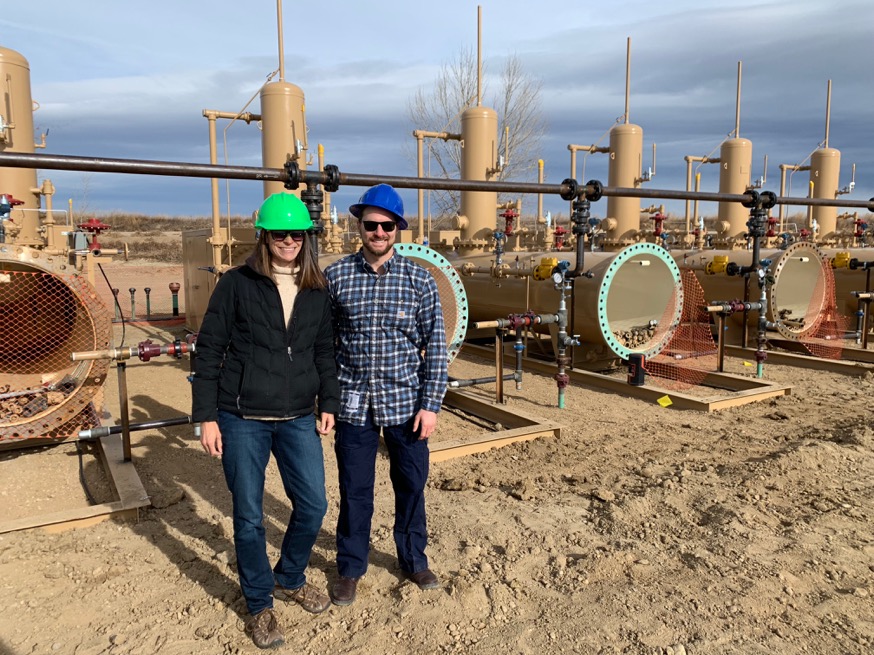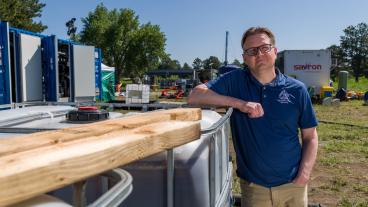Can we reuse produced water? Yes, just add bacteria.
A team of scientists from the U.S. Department of Energy’s Lawrence Berkeley National Laboratory and Colorado School of Mines is developing a microbe-based system that could remove toxic compounds from produced water so it can be reused in other water-intensive sectors.
 Drilling a single oil or natural gas well with hydraulic fracturing requires between 1.5 to 16 million gallons of water. When the well starts flowing, the fluid that is brought back to the surface alongside the oil and gas is a combination of the injection fluid and brine from aquifers – a difficult-to-treat mixture known as produced water. Brimming with hydrocarbons, harsh salts and industrial chemicals, the vast majority of produced water is injected into disposal wells after it is collected. Currently, less than 1 percent of the billions of gallons generated each year is reused.
Drilling a single oil or natural gas well with hydraulic fracturing requires between 1.5 to 16 million gallons of water. When the well starts flowing, the fluid that is brought back to the surface alongside the oil and gas is a combination of the injection fluid and brine from aquifers – a difficult-to-treat mixture known as produced water. Brimming with hydrocarbons, harsh salts and industrial chemicals, the vast majority of produced water is injected into disposal wells after it is collected. Currently, less than 1 percent of the billions of gallons generated each year is reused.
How can this “wastewater” be turned into usable water? One answer: Let microbes do the work.
A team of scientists from the U.S. Department of Energy’s Lawrence Berkeley National Laboratory and Colorado School of Mines is developing a microbe-based system that could remove toxic compounds from produced water so it can be reused in other water-intensive sectors such as agriculture and energy production. Their new project is part of a wave of recent research aimed at harnessing biological systems – rather than expensive, high-tech equipment or intense chemical cocktails – to clean water.
“We know that microbes are excellent for cleaning water,” said Susannah Tringe, co-lead of the Berkeley Lab group and a microbial genomics researcher within the Environmental Genomics and Systems Biology Division. “Scientists have shown the potential of using microbial communities to remove excess phosphorus and nitrogen from various other types of wastewater, including municipal water, and in removing toxic plastic contaminants from water used at manufacturing plants. And almost all cities have been using microbiological treatment for sewage water for years.
“The human demand for freshwater is growing – yet our natural resources are nearly tapped out, and climate change is expected to make it worse. It’s urgent that we find ways to reuse the water we’ve already taken from the environment,” Tringe added.
A proven treatment option
The process for microbiological water treatment is straightforward, at least in theory: Figure out what microbes will break down the contaminants of concern and grow them in a container, called a bioreactor. When you add wastewater to this community, one or more species will metabolize the toxic compounds into different molecules, which are then gobbled up by a new set of species, and so on. This cycle continues, ideally, until only benign byproducts such as water, nitrogen gas, and carbon dioxide are left. After running through a simple filtration and disinfection system, the water can be safely reintroduced into watersheds or utilized for most industrial applications.
Energy-efficient and highly cost-effective compared with other approaches, microbial treatment is considered one of the best ways to remove dissolved organic constituents and nutrients from contaminated water. Because the technique depends on combining many microbial species with very specific metabolic abilities, each type of wastewater requires a unique microbial recipe. Unfortunately, finding the correct recipe can be time-intensive.
Most of the sewage-treating microbial communities – known as “sludge microbiomes” – in widespread use today were put together through laborious trial and error experiments that involved taking samples of microbes that occurred naturally in sewage, culturing them in various mixtures in tanks, and waiting until an effective yet stable group emerged.
Under a grant from the National Science Foundation, the team based at Mines has spent the last several years working to acclimate microbes taken from both a sludge microbiome and several natural extreme environments. A team led by Civil and Environmental Engineering Professor Tzahi Cath at Mines has demonstrated in small-scale experiments that some microbes are capable of adapting their metabolism and physiology to feed on produced water constituents and survive in water that is inhospitable and potentially toxic to most organisms.
However, the community needs further optimization to be efficient, and the team saw an opportunity to collaborate with scientists with genomic expertise and equipment in order to expedite and enhance the microbes’ evolution. Even now, in an era when scientists can easily genetically modify microbes to perform specialized functions by inserting genes for select proteins, designing a treatment microbiome is no simple task. The difficulty lies in discovering which naturally occurring proteins can actually perform the functions of interest, and then figuring out what gene or genes encode those proteins.
“Our end goal is to develop a complete treatment system that can remove the pollutants from produced water in 24 to 48 hours,” said Cath, who initiated the produced water treatment project. “We need to figure out which microbes are the important players – the most active, the most dominant – and ideally what genes or pathways they turn on and off. Then, we can improve how well we degrade the unwanted compounds by enhancing the activity of those microbes in the bioreactors.”
Expediting innovation
This is where Berkeley Lab comes in. Sleuthing out the useful capabilities of microbial communities is one of the Lab’s core strengths. Tringe and her co-investigators, Romy Chakraborty and William Stringfellow of the Earth and Environmental Sciences Area, were drawn to the Mines project because it allows them to flex their microbial research muscles for another of Berkeley Lab’s priorities: developing new technologies to address water-energy challenges. These efforts are part of the multidisciplinary Water-Energy Resilience Research Institute (WERRI)at Berkeley Lab.
“You cannot produce oil without water. On average, 15 barrels of wastewater are produced for every barrel of oil extracted from the formation, and 130 billion gallons of wastewater are produced each year by oil and gas extraction in California alone,” said Chakraborty, who is the co-lead of the Berkeley Lab team and head of the Ecology Department. “The water is then typically injected back into very deep formations, discharged to surface waters after some minor treatment, or sometimes carted off to languish in some pond. Yet, in the same state, an economically important agricultural region, farmers are facing uncertainty and unease due to frequent drought events. This research project will allow us to turn an environmental liability into a resource.”
The Berkeley Lab team has begun using their cutting-edge sequencing and analysis tools to profile the genes and proteins of the Mines group’s adapted microbiomes. The scientists are also working to characterize the many different contaminants that can appear in produced water – which is known to vary greatly between oil and gas production sites and even individual wells at the same site – so they will have a clearer picture of what metabolic capabilities the microbiomes will require. Removing the dissolved salts in produced water, however, cannot be efficiently performed with microbes, and will involve an additional desalination process during treatment.
By 2020, the team hopes to begin cultivating the microbes in carefully designed communities within bioreactors and testing how well they treat produced water under various conditions.
“Our collaboration is trying to tailor a system with a diverse and rich microbial community that can handle these changes and variabilities,” said James Rosenblum, a research assistant professor at Mines and the managing director of the WE2ST Water Technology Hub. “We hope that an optimized biological system could play a major role in various produced water treatment processes, just as it does in most municipal and industrial processes around the globe, and we believe this partnership is helping us towards that goal.”
The Berkeley Lab side of the project, which also includes Shwetha Acharya, is funded by the Laboratory Directed Research and Development (LDRD) program. The team at Mines also includes Brett Van Houghton and is funded by the National Science Foundation and the Zoma Foundation.
(This article originally appeared on the Lawrence Berkeley National Laboratory News Center: https://newscenter.lbl.gov/2019/07/29/cleaning-oil-and-gas-water/.)
CONTACT
Aliyah Kovner, Science Communications & Media Relations, Lawrence Berkeley National Laboratory | 510-486-6376 | akovner@lbl.gov
Emilie Rusch, Public Information Specialist, Communications and Marketing | 303-273-3361 | erusch@mines.edu




